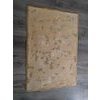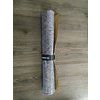2 0 1 8 - 0 5 - 1 4
[Song of Fork and Heroes]¶
Mythical Agyptian Palm Groves¶
I added the same two tones of flock to the bases as for the miniatures and the terrain done previously.
I then started to spray paint the leaves in dark green. On the left is the original olive, the right one is the colour I sprayed.
On the top side I then sprayed a mid green.
I then mounted the leaves three to a trunk.
Published 2018-05-14 20:57:15
28mm | Agyptians | Song of Fork and Heroes | Terrain | Weird Ancients
All posts for this project: newest first | oldest first.
2 0 1 8 - 0 4 - 1 6
[Song of Fork and Heroes]¶
Mythical Agyptian Palm Groves¶
All the trunks and palm leaves are cleaned.
I used air drying clay to build up some small mounds into which I pressed the palm trunks.
The oasis was filled with a thin layer of leveling compound to hide the texture of the floor tiles. I then glued on some smaller rocks, before covering the whole base in PVA + my base colour and sprinkled on fine sand.
Published 2018-04-16 16:04:48
28mm | Agyptians | Song of Fork and Heroes | Terrain | Weird Ancients
All posts for this project: newest first | oldest first.
2 0 1 8 - 0 3 - 1 7
2018-03-17 [Song of Fork and Heroes]¶
Mythical Agyptian Palm Groves¶
My Agyptian Terrain needs some vegetation. I have these plastic cake decoration palm trees for several years lying around, so I thought this would be a good opportunity to give them some purpose.
For the bases I again used the off-cuts of the floor tiles. I cut them in a way, that they fit in my standard storage box.
The edges were curved in random shapes and then beveled.
Here are the palms.
They were dirt cheap, the quality is accordingly. So I had to do quite some cutting and trimming on the trunks.
The leaves also need some trimming,
Published 2018-03-17 21:17:05
28mm | Agyptians | Song of Fork and Heroes | Terrain
All posts for this project: newest first | oldest first.
2 0 1 8 - 0 1 - 1 5
[Song of Fork and Heroes]¶
Mythical Agyptian Terrain Mat¶
I used the same flock I already applied to the miniature's bases, basecoating with the dark one and sprinkling on highlights with the light one.
The mat after the flocking:
I then used the bottom of the board as a guide for cutting the mat. This meant that the parts folded over the sides remained. Those I painted with the base ochre brown, which gives me a nice frame.
Here is the mat with some terrain on and my Agyptians scouring the area for Richards pesky Greeks.
Here is the mat rolled up.
Published 2018-01-15 10:38:22
28mm | Agyptians | Song of Fork and Heroes | Terrain
All posts for this project: newest first | oldest first.
2 0 1 8 - 0 1 - 1 0
[Song of Fork and Heroes]¶
Mythical Agyptian Terrain Mat¶
A second coat gave a much better coverage.
I then used the same sand colour as for the obelisks and statues.
Then the whole board got a drybrush of white.
Published 2018-01-10 11:07:09
28mm | Agyptians | Song of Fork and Heroes | Terrain
All posts for this project: newest first | oldest first.
2 0 1 7 - 1 2 - 3 1
[Song of Fork and Heroes]¶
Mythical Agyptian Terrain Mat¶
This is how the mat looked after a second layer of acrylic. It took me about 1.5 tubes.
I then applied thinned PVA glue (1:1) and sprinkled on two grains of sand. Here is the first learning: When applying white PVA onto a white surface, tint it with something. I went with the reflection of light, and thought I got everything coated - when I tapped off the excess sand, there were some quite visible spare patches. I touched them up, but they are visible now as they are a bit higher than the rest...
After sealing the sand in with watered down PVA (1:6 + washing-up liquid) and letting this coat dry thoroughly, I stippled on a first coat of paint.
Published 2017-12-31 05:54:15
28mm | Agyptians | Song of Fork and Heroes | Terrain
All posts for this project: newest first | oldest first.
[Song of Fork and Heroes]¶
Mythical Agyptian Scatter Terrain¶
I gloss varnished the models, then applied oil washes.
After a layer of matt varnish, I added the same bushes and flock I put on the miniature's bases as well.
Done.
Published 2017-12-31 05:37:22
28mm | Agyptians | Green Stuff World | Song of Fork and Heroes | Terrain
All posts for this project: newest first | oldest first.
[Song of Fork and Heroes]¶
Mythical Agyptian Terrain¶
I gloss varnished the models, then applied oil washes.
After a layer of matt varnish, I added the same bushes and flock I put on the miniature's bases as well.
Done.
Published 2017-12-31 05:37:09
28mm | Agyptians | Hirst Arts | Song of Fork and Heroes | Terrain
All posts for this project: newest first | oldest first.
2 0 1 7 - 1 2 - 2 8
[Song of Fork and Heroes]¶
Mythical Agyptian Terrain Mat¶
With the miniatures done and some terrain under way, I need a gaming table. What I wanted to do for quite some time is a flexible gaming mat.
I watched plenty of YouTube videaos on the topic, but the recently published video by the Terrain Tutor was the tip on the dare to give it a try.
Here are the components:
As fabric, I use painter fleece, the one I choose has a bottom of plastic sheeting, which should help keeping the acrylic and the colour on the fleece.
I pinned the fleece to the board with pins.
Then added one thin layer of acrylic.
Published 2017-12-28 11:13:16
28mm | Agyptians | Song of Fork and Heroes | Terrain
All posts for this project: newest first | oldest first.
2 0 1 7 - 1 2 - 2 3
[Song of Fork and Heroes]¶
Mythical Agyptian Terrain¶
I basecoated the sand in ochre brown, the structures in sand.
The base was then drybrushed in ochre.
This was followed by a drybrush of white over everything.
Published 2017-12-23 11:49:25
28mm | Agyptians | Hirst Arts | Song of Fork and Heroes | Terrain
All posts for this project: newest first | oldest first.






































